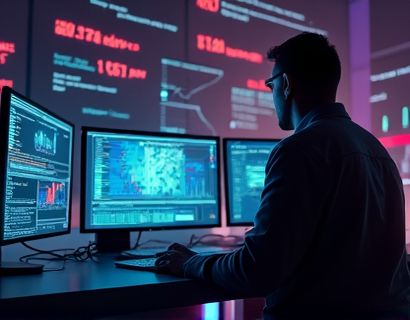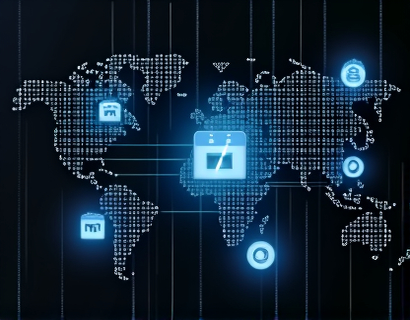Blockchain-Enabled Real-World Asset Tokenization: Unlocking Liquid Value and Market Potential
Blockchain technology is at the forefront of a transformative shift in asset management, offering a novel way to tokenize real-world assets. This innovative approach not only enhances liquidity but also broadens market accessibility, creating a more efficient and transparent environment for asset holders and investors alike. By integrating physical assets into the digital ecosystem, blockchain enables a seamless transition from traditional asset management to a more modern, tech-driven model.
The concept of tokenization involves representing real-world assets, such as real estate, art, and infrastructure, as digital tokens on a blockchain. These tokens are unique digital representations that carry the same rights and values as their physical counterparts. The process begins with the identification and valuation of the asset, followed by the creation of a smart contract that defines the terms and conditions of the token. This smart contract is then deployed on a blockchain network, ensuring immutability and transparency.
One of the primary benefits of blockchain-enabled asset tokenization is the enhancement of liquidity. Traditional real-world assets are often illiquid, meaning they cannot be easily bought or sold without significantly affecting their price. Tokenization changes this dynamic by breaking down these assets into smaller, tradable units. This granularity allows for more flexible trading and investment opportunities, as tokens can be bought and sold on various platforms, similar to stocks or cryptocurrencies.
For instance, a piece of commercial real estate valued at millions of dollars can be tokenized into thousands of smaller units, each representing a fraction of the property. This division makes it possible for a broader range of investors to participate in the market, including those with smaller capital bases. The increased participation can lead to higher trading volumes and more competitive pricing, ultimately benefiting all market participants.
Moreover, tokenization streamlines transactions by reducing the need for intermediaries such as brokers, lawyers, and banks. Smart contracts automate and enforce the terms of the transaction, ensuring that all parties adhere to the agreed-upon conditions. This automation not only speeds up the process but also reduces costs associated with traditional transaction methods. The reduced friction and lower fees make the market more accessible and attractive to a wider audience.
Transparency is another critical advantage of blockchain-based asset tokenization. All transactions and asset details are recorded on a public ledger, which is accessible to anyone with the necessary permissions. This level of transparency builds trust among participants, as there is no room for fraud or manipulation. Investors can verify the authenticity and value of the assets they are interested in, leading to more informed decision-making.
The integration of real-world assets into the blockchain ecosystem also opens up new market potentials. Assets that were previously difficult to trade or value can now be tokenized and traded on global markets. For example, intellectual property, such as patents and copyrights, can be tokenized, allowing creators to monetize their work more effectively. Similarly, environmental assets like carbon credits can be tokenized, facilitating more efficient trading and compliance with environmental regulations.
In the realm of real estate, tokenization can democratize property investment. Traditional real estate investment requires significant capital and often involves complex legal processes. With tokenization, individuals can invest in real estate projects with minimal upfront costs and without the need for extensive legal involvement. This democratization can lead to a more diverse and inclusive investment landscape, where more people have the opportunity to participate in the real estate market.
Infrastructure projects, such as bridges, roads, and public utilities, can also benefit from tokenization. By issuing tokens representing shares in these projects, governments and private entities can raise capital more efficiently. Investors can purchase these tokens and receive returns based on the project's performance, providing a new avenue for public-private partnerships and infrastructure financing.
The financial sector stands to gain significantly from blockchain-enabled asset tokenization as well. Asset-backed securities, such as bonds and loans, can be tokenized, offering investors greater flexibility and liquidity. This tokenization can lead to the creation of new financial instruments and markets, enhancing the overall efficiency of capital allocation. Additionally, the reduced need for intermediaries can lower transaction costs and improve the speed of financial transactions.
However, the path to widespread adoption of blockchain-based asset tokenization is not without challenges. Regulatory frameworks need to evolve to accommodate this new paradigm. Governments and regulatory bodies must establish clear guidelines to ensure the security, compliance, and stability of tokenized assets. This includes addressing issues related to anti-money laundering (AML), know-your-customer (KYC), and tax regulations.
Technical challenges also persist, such as scalability and interoperability. Blockchain networks must be able to handle a large volume of transactions efficiently, and different blockchain platforms need to work seamlessly together to facilitate cross-chain asset transfers. Continuous innovation and collaboration among developers, regulators, and industry stakeholders are essential to overcoming these technical hurdles.
Despite these challenges, the potential benefits of blockchain-enabled real-world asset tokenization are substantial. By unlocking the liquid value of physical assets and expanding market accessibility, this technology can drive significant economic growth and innovation. It can empower individuals and businesses to explore new investment opportunities, create value, and participate in a more dynamic and inclusive market.
In conclusion, blockchain technology is revolutionizing asset management through the tokenization of real-world assets. This approach enhances liquidity, reduces transaction costs, and increases market transparency and accessibility. As the technology matures and regulatory frameworks adapt, the integration of physical assets into the blockchain ecosystem will continue to unlock new possibilities, driving a more efficient and prosperous global economy.










































